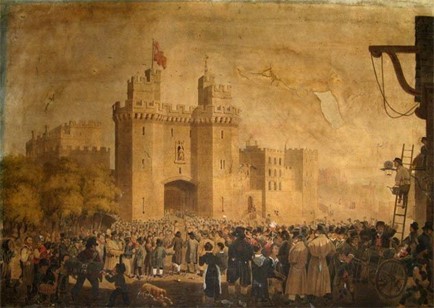Written By Rianna Husein
The year is 1612, not a year that is drilled into the average person’s brain of a year of significance; for historians and avid researchers this date marks a year of prominence in British History. This was a time of dark tales of imprisonment and execution at Lancaster Castle where twelve people were accused of witchcraft.

Witchcraft was an accepted part of village life in the 16th century, this was due to there being village healers who practiced magic and dealt in herbs and medicines. The extent of witchcraft reported in Lancaster reflected the large amounts of money people could make by posing as witches. Much like today’s doctors, people would seek help from these ‘healers’ and would pay for their expertise and magic abilities. It was feared, but also fascinated many from commoners to King James. James I, even before his coronation, was fascinated in the practice; he wrote a book in 1597 called ‘Daemonologie’. Across three books he assesses magic, sorcery and witchcraft. In the book he encourages the prosecution of those who practice and support it.
The King’s views became apparent in Lancaster, when he ordered a list of all those who refused to attend Church or take communion. Lancashire had been regarded as a ‘wild and lawless society’. They had a sympathy for the Catholic Church. During the Dissolution of the Monasteries in 1536-1541 when Henry had turned the country protestant, the people of Pendle Hill openly opposed the closures of their local Abbey and in 1553 reverted back to Catholicism under Mary I rule. It was due this reputation and unease of the town that two judges made their investigations and sentenced the Pendle witches.

The actual accusations may have begun as a simple feud between two families, the Chattoxs and the Demdikes. The families had been feuding for years, since one of the Chattox family broke into the home of the Demdikes and stole £100, worth of today’s money, in goods. A member of the Demdikes, Alizon, was accused of cursing John Law, who had refused her some pins. After the altercation between the two, John suffered a stroke and blamed Alizon claiming she used her powers. Upon further questioning , Alizon accused her grandmother, Old Demdike and members of the Chattox family of witchcraft. Old Demdike (real name Elizabeth Southerns), was a very old woman. She had been regarded as a witch for fifty years. The accusations on the Chattox family seem to have been an act of revenge. Alizon, amongst 19 others were put on committed to trial in 1621, thus began The Pendle Witch Trials.
The Witch Trials success, if you can call it that, was owed largely to a nine year old girl; Jennet Device. She was an illegitimate beggar and would have been lost to history without her contributions to the trials. The evidence she gave resulted in the death of 10 accused witches, including her whole family. Her mother, Elizabeth, had hosted a party on Good Friday, when all “good citizens” should have been in church, which caused a local constable to hear rumors of a meeting of witches and the arrest of her family.

It is said that during the trials, Jennet was very calm and convincing whilst she gave evidence against her mother, siblings and neighbors. In ‘The Wonderful Discoverie of Witches in the Countie of Lancaster’, it states that Elizabeth screamed out when her daughter entered the court. Jennet demanded she be removed and then climbed on a table and calmly denounced her as a witch.
She said: “My mother is a witch and I know that to be true. I have seen her spirit in the likeness of a brown dog which she calls ball. The dog did ask what she would have him do and she answered she would have hum help her kill”. Whilst it seems cruel to call upon a child to, in essence, sentence her family to death, some believe that the prosecution used the words of James I’s book to aid in their verdict. In his book her writes… “Children, women and liars can be witnesses over high treason against God.” This may have influenced the justice system and led to them using Jennet, as his key witness with God on their side.
Sadly, history remembers Jennet as an evil child, one that turned against her entire family. This seems an unfair accusation. Much of her family turned against each other in the fight for survival. It is said that the family showed little affection towards each other and Jennet was treated poorly. As a young girl she was thrown into the life of witchcraft and heresy. Jennets contribution to the Pendle Witch trials caused a ripple effect, even influencing how the Salem Witch Trials in 1692 where investigated, most of the evidence was given by children. There had been evidence of earlier cases where children were witnesses in witch trials before Pendle, but the law stated those under 14 were not credible enough witnesses because they could not swear under oath. Jennet’s testimony changed all that.

Not much was heard of Jennet in the years after the trials, however in 1633 she ironically was accused of witchcraft herself along with 16 others the key witness being 10-year-old Edmund Robinson. She was found guilty, but due to skepticism from the judges they demanded physical evidence, of which there was none. Edmund eventually admitted to lying and said it was due to hearing of the Pendle Trials twenty years earlier. Whilst she was acquitted of the charges, she was not allowed to leave Lancaster Castle, where she was held until she had paid her board, for someone like her this was impossible. The last known record of Jennet was in 1636, the general consensus is she died in the castle.
References:
http://www.pendlewitches.co.uk
https://www.thehistorypress.co.uk/articles/the-pendle-witches/
https://www.lancastercastle.com/history-heritage/further-articles/the-pendle-witches/
https://www.bbc.co.uk/news/magazine-14490790
https://www.british-paranormal.co.uk/jennet-device-the-child-behind-the-pendle-witch-trials/
Featured image courtesy of Wikimedia Commons. Image found here.
